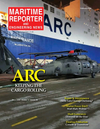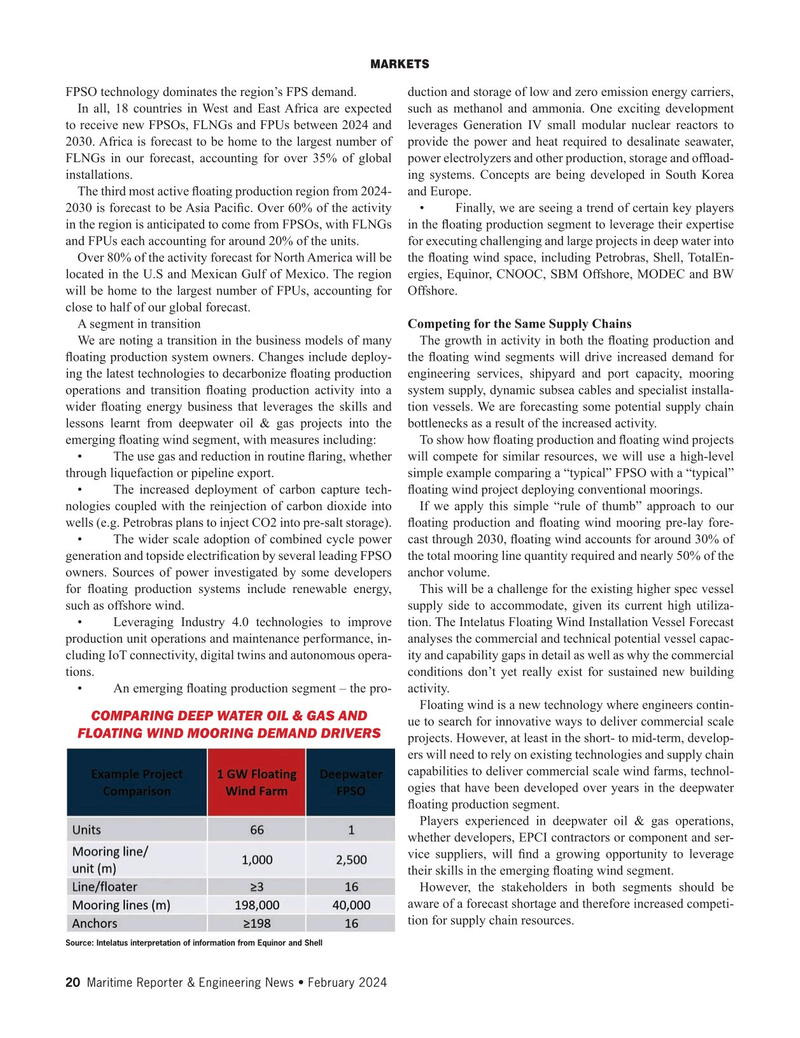
Page 20: of Maritime Reporter Magazine (February 2024)
Read this page in Pdf, Flash or Html5 edition of February 2024 Maritime Reporter Magazine
MARKETS
FPSO technology dominates the region’s FPS demand. duction and storage of low and zero emission energy carriers,
In all, 18 countries in West and East Africa are expected such as methanol and ammonia. One exciting development to receive new FPSOs, FLNGs and FPUs between 2024 and leverages Generation IV small modular nuclear reactors to 2030. Africa is forecast to be home to the largest number of provide the power and heat required to desalinate seawater,
FLNGs in our forecast, accounting for over 35% of global power electrolyzers and other production, storage and of? oad- installations. ing systems. Concepts are being developed in South Korea
The third most active ? oating production region from 2024- and Europe.
2030 is forecast to be Asia Paci? c. Over 60% of the activity • Finally, we are seeing a trend of certain key players in the region is anticipated to come from FPSOs, with FLNGs in the ? oating production segment to leverage their expertise and FPUs each accounting for around 20% of the units. for executing challenging and large projects in deep water into
Over 80% of the activity forecast for North America will be the ? oating wind space, including Petrobras, Shell, TotalEn- located in the U.S and Mexican Gulf of Mexico. The region ergies, Equinor, CNOOC, SBM Offshore, MODEC and BW will be home to the largest number of FPUs, accounting for Offshore.
close to half of our global forecast.
A segment in transition Competing for the Same Supply Chains
We are noting a transition in the business models of many The growth in activity in both the ? oating production and ? oating production system owners. Changes include deploy- the ? oating wind segments will drive increased demand for ing the latest technologies to decarbonize ? oating production engineering services, shipyard and port capacity, mooring operations and transition ? oating production activity into a system supply, dynamic subsea cables and specialist installa- wider ? oating energy business that leverages the skills and tion vessels. We are forecasting some potential supply chain lessons learnt from deepwater oil & gas projects into the bottlenecks as a result of the increased activity.
emerging ? oating wind segment, with measures including: To show how ? oating production and ? oating wind projects • The use gas and reduction in routine ? aring, whether will compete for similar resources, we will use a high-level through liquefaction or pipeline export. simple example comparing a “typical” FPSO with a “typical” • The increased deployment of carbon capture tech- ? oating wind project deploying conventional moorings. nologies coupled with the reinjection of carbon dioxide into If we apply this simple “rule of thumb” approach to our wells (e.g. Petrobras plans to inject CO2 into pre-salt storage). ? oating production and ? oating wind mooring pre-lay fore- • The wider scale adoption of combined cycle power cast through 2030, ? oating wind accounts for around 30% of generation and topside electri? cation by several leading FPSO the total mooring line quantity required and nearly 50% of the owners. Sources of power investigated by some developers anchor volume. for ? oating production systems include renewable energy, This will be a challenge for the existing higher spec vessel such as offshore wind. supply side to accommodate, given its current high utiliza- • Leveraging Industry 4.0 technologies to improve tion. The Intelatus Floating Wind Installation Vessel Forecast production unit operations and maintenance performance, in- analyses the commercial and technical potential vessel capac- cluding IoT connectivity, digital twins and autonomous opera- ity and capability gaps in detail as well as why the commercial tions. conditions don’t yet really exist for sustained new building • An emerging ? oating production segment – the pro- activity.
Floating wind is a new technology where engineers contin-
COMPARING DEEP WATER OIL & GAS AND ue to search for innovative ways to deliver commercial scale
FLOATING WIND MOORING DEMAND DRIVERS projects. However, at least in the short- to mid-term, develop- ers will need to rely on existing technologies and supply chain capabilities to deliver commercial scale wind farms, technol- ogies that have been developed over years in the deepwater ? oating production segment.
Players experienced in deepwater oil & gas operations, whether developers, EPCI contractors or component and ser- vice suppliers, will ? nd a growing opportunity to leverage their skills in the emerging ? oating wind segment.
However, the stakeholders in both segments should be aware of a forecast shortage and therefore increased competi- tion for supply chain resources.
Source: Intelatus interpretation of information from Equinor and Shell 20 Maritime Reporter & Engineering News • February 2024
MR #2 (18-33).indd 20 2/6/2024 9:09:46 AM

 19
19

 21
21
